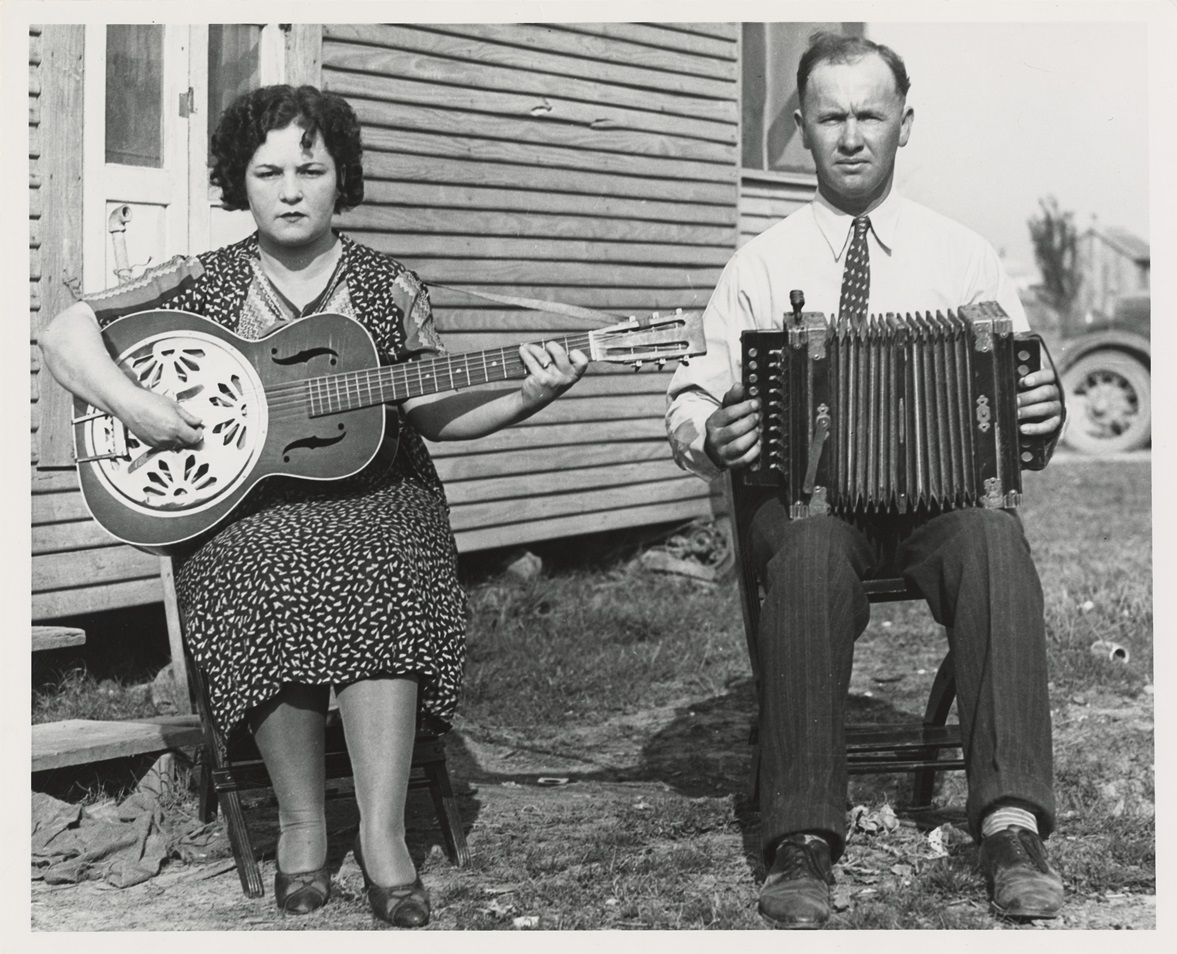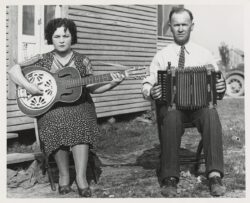Magazine
Culture Shock
Discovering Cajun and Creole music
Published: November 30, 2023
Last Updated: March 1, 2024

Photo by Lauren C. Post, The Historic New Orleans Collection
Joe and Cleoma Falcon, 1934.
Artists and repertoire (A&R) scouts spent time away from their corporate offices, sometimes for weeks, bouncing from town to town in the American South, on the lookout for the next big artist. They were copying the tactics perfected by Victor Records’ famed A&R scout Ralph Peer, who successfully found “hillbilly” artists and “old-time” players in the southeast. Frank Buckley Walker, Columbia Records’ renowned A&R scout, followed the same methodology. Down in the Louisiana prairies, he overheard a curious style of music. “I went up to Lafayette for a weekend,” recalled Walker in a 1962 interview with Mike Seeger. “I happened to know something of the story of the Cajuns and was astounded at the interest that there was in their little Saturday night dances.” This led Walker to reach out to a local distributor in Rayne, Louisiana, named George Ber, who recommended Walker record relatively unknown musicians Joe Falcon and Cléoma Breaux. Together, they became the first commercially Cajun recording artists.
Columbia Records’ success led to other artists signing contracts with traveling scouts. Vocalion Records’ Richard Voynow scoured the bayous on a multi-month trip in 1929 and “discovered” everyone from Dennis McGee and Sady Courville to Blind Uncle Gaspard and Delma Lachney. In a 1974 interview with Douglas Green, Voynow’s colleague Art Satherley recalled, “I would be down on the bayous in Louisiana, and there I’d be probably on a raft! Going across the water to some bayou singers.” Occasionally, Cajun and Creole artists took a chance to land a recording contract based on a hunch. Dewey Segura, while on a bootleg whiskey run, saw an advertisement to get paid to record in New Orleans; he showed up with his brother and auditioned, which led to him recording twice, in 1928 and 1929. In other cases A&R scouts relied on local Cajun record distributors. In 1928 Victor Records’ Ralph Peer contacted regional record distributor Frank Dietlein of Opelousas, who was a reliable source of information on local talent, and “discovered” Leo Soileau and Mayuse Lafleur. RCA’s Eli Oberstein contacted regional record distributor Hilman Bailey of Rayne, who helped him “discover” the Rayne-Bo Ramblers, the Hackberry Ramblers, and the Dixie Ramblers all from one talent contest in 1935.
“We don’t know what you’re singing. We ask you just one thing: don’t sing anything dirty.”
Once in the studio A&R scouts and recording engineers didn’t know what to make of the instrumentation. “A single singer would have a little concertina-type instrument and a one-string fiddle and a triangle, those were the instruments, but they would always have a singer,” explained Walker in his interview with Seeger. His description highlights the disconnect between what the record executives were used to recording versus what Cajuns and Creoles typically used in their ensembles. When the Breaux Brothers arrived in San Antonio, Texas, their instrumentation left Vocalion Records’ A&R scout Don Law in disbelief. “It was an accordion—or a concertina, actually—and a fiddle, and banjo, I think, if I remember,” Law said in a 1975 interview with Douglas Green. “When I first heard this stuff, I thought, ‘My God, this can’t be. It’s impossible.’”
Everything about the music was otherworldly and working with it wasn’t always easy. “Of course, they sang in Cajun,” recalled Walker to Seeger. “And to me it had a funny sound.” For some, the Cajun accordion seemed dissonant and ear-splitting. “I noticed that all of [Peer’s] engineers had placed wads of cotton in their ears,” recalled Dietlein to the press in 1965. Scouts like Don Law admitted they grew fond of the unique sound, eventually. He recalled to Douglas Green, “After a few days, I began to like it.”
Cultural differences continued to present challenges. Many of the Cajun and Creole artists spoke only French, forcing recording reps to bring along local agents to translate. Record executives routinely butchered the spellings of the song titles they overheard. The mostly English-speaking recording engineers could not understand the artists’ accents. When the Segura Brothers arrived in New Orleans, Columbia Records engineers explained, “We don’t know what you’re singing. We ask you just one thing: don’t sing anything dirty.”
The remote places chosen by A&R scouts were notoriously unsuited for recording sessions. Leo Soileau and Mayuse LaFleur were recorded via a dangling microphone in the middle of a building that doubled as a KKK meeting hall. Amédé Ardoin and Dennis McGee recorded at the Texas Hotel in San Antonio, Texas; whenever the elevator was used, the power elsewhere in the hotel would destabilize, causing the recording motor to lag and ruining the master disc.
Even with all the challenges facing the fledgling recording genre, the commercial success of recorded Cajun and Creole music throughout the region was undeniable. After Joe Falcon’s acclaimed “Lafayette” was released in August 1928, Walker was astounded. “We put it on the market, and it had tremendous sales,” said Walker to Seeger. “Definitely local sales extending all over the state of Louisiana and some of Texas, because there is a great many of the Cajuns living over in Texas. It was amazing that you could sell fifty or sixty thousand records in a locality of that size.”
By the end of the 1930s hundreds of songs were recorded by dozens of Cajun and Creole artists stemming from almost every parish in Acadiana. The recording industry embraced Cajun music as deeply as other rural genres of Americana, such as Tejano music and Hawaiian music. By World War II, although the music had succumbed to more western trends, Cajun music as a genre retained a strong foothold in South Louisiana, influencing generations of new musicians throughout the latter part of the twentieth century and into the twenty-first. We have the ambition of home-grown Cajun and Creole artists and the business acumen of curious recording scouts to thank for that.
Wade Falcon is a Lafayette-based researcher and writer of both early Cajun music and colonial Spanish Louisiana. Currently, he is the vice-president of the Canary Islanders Heritage Society of Louisiana the author of an upcoming book about the lives of Joe and Cleoma Falcon, the first Cajun music recording artists. Son of accordion maker Randy Falcon, he has published several articles regarding the Falcon family’s musical history as well as the life and times of other early Cajun music artists of the 1920s and 1930s.
